1. Can we end homelessness? How?
You will likely notice in the video segments that follow, that we often prefaced this question by calling it “the big one.” After the camera stopped recording in one interview, the conversation continued as one researcher raised an interesting query about whether people’s responses might differ depending on the stage of their career. Would people who are newer to the field have more optimism or see the hurdles as insurmountable? Would people who are more established in their career feel compassion fatigue (you remember that from the Social Work chapter, right?), or would they be eager to build on the networks and connections they have developed? After seeing the collection of responses together, we can certainly attest that people at all stages of their career remained passionate about ending homelessness. Whether they felt we were on the right track as a country, is something we will let you explore for yourself.
Before you begin this concluding chapter, we encourage you one last time to consider the question before exploring the range of responses. After all that you have learned, what is your opinion? Can we end homelessness? If so, how? Use the space below to record your thoughts. You may write as little or as much as you wish to answer these questions.
How to complete this activity and save your work: Type your response to the question in the box below. When you are done answering the question navigate to the ‘Export’ page to download and save your response. If you prefer to work in a Word document offline you can skip right to the Export section and download a Word document with this question there.
Homelessness is a complicated issue. However, when we asked the researchers the final question about whether we can end it, and if so how, the answers were surprisingly clear. Although they picked up on different themes or said things in different ways, their responses collectively identified four key priorities that need to be addressed before we can end homelessness in Canada. These priority areas are overlapping and have to be implemented together to be effective. To end homelessness, we must: [1] recognize housing as a human right and create deeply affordable housing to ensure that right is met, [2] implement individualized choice-based supports following the Housing First principles to ensure people’s unique needs are met, [3] hold the government accountable for their social policy choices in the past, present, and future, and [4] prevent homelessness from occurring in the first place by implementing systemic change.
In this chapter, we explore each of these priority areas by focusing on the researchers’ responses. We would like to note that in writing this chapter and presenting the material, we made the choice of which theme to include each researcher in. This does not mean that they only argued for that priority, but rather that we felt they made a strong case for it in their response. As you will see, the researchers all provided thoughtful responses that spanned across many of the priority areas. The choice to assign them to one theme or another was ours. We invite you to join us in exploring each of these priority areas and seeing firsthand the responses we received to the questions: Can we end homelessness and, if so, how?
[1] Creating deeply affordable housing as a human right
The idea that housing is a human right is a simple concept, but it had not been officially recognized in Canada until recently with the implementation of the National Housing Strategy (Government of Canada, 2017) and passing of the affiliated National Housing Strategy Act (Government of Canada, 2019). We have seen throughout this book that a lack of housing is a social determinant that is at the root of many challenges, traumas, and hardships associated with homelessness. Implementing the legislation and seeing housing realized as a human right in Canada will require thoughtful consideration; much of this work has already begun (Biss & Raza, 2021; CERA & NRHN, 2021; Porter, 2021; Schwan, Vaccaro, Redi, & Ali, 2021). What we heard from researchers is that we must stop thinking of housing as a commodity that generates wealth, and instead begin to invest in developing deeply affordable housing as a human right.
We have selected four researchers who included this priority in their discussion about ending homelessness in Canada. Here we invite you to watch the responses of Dr. Jonathan Greene, Dr. Naomi Nichols, Dr. Abe Oudshoorn, and Dr. Kaitlin Schwan. You may watch them, in any order you wish, by clicking on the images, which will open the videos in a new window. We encourage you to also review the key takeaways in the box that follows! As you watch the videos, try to keep the other priorities in your mind as well, to see if you can pick up on how they intersect with one another.
 |
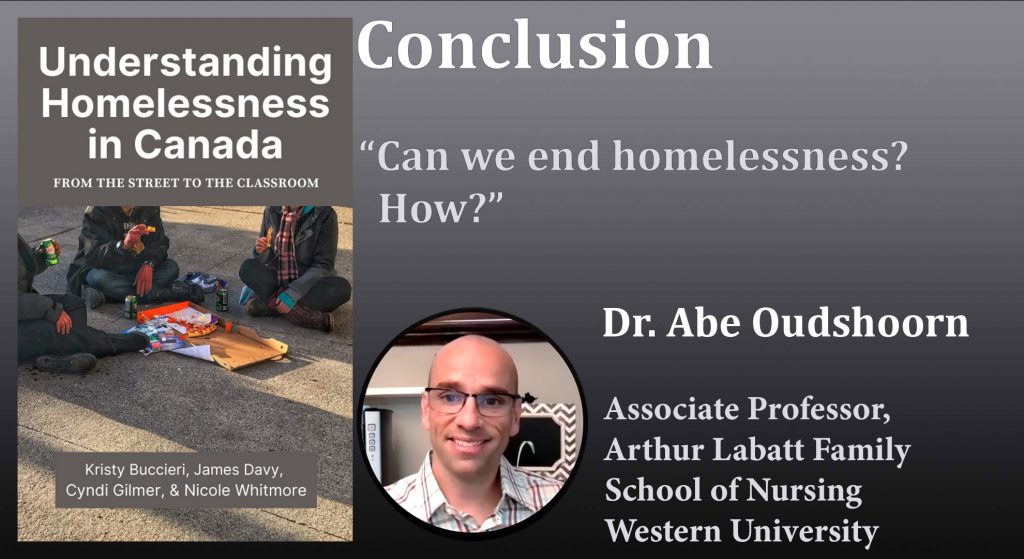 |
 |
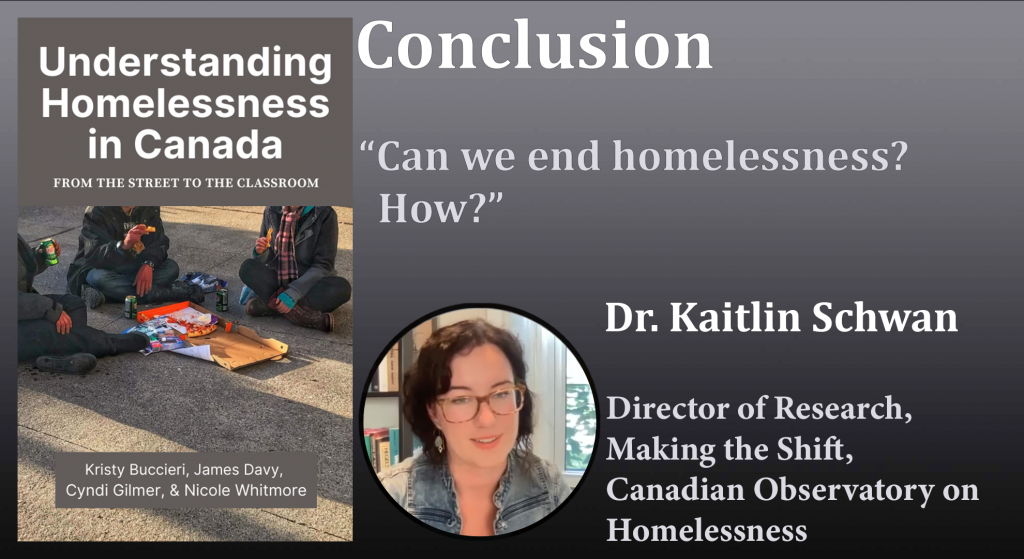 |
Key Takeaways – Greene, Nichols, Oudshoorn, and Schwan: Can we end homelessness? How?
Dr. Jonathan Greene:
- Ending homelessness is possible but it has to involve a long-term strategy in which we identify and then implement the building blocks that need to be in place.
- We need to come up with a shared understanding of what it means to end homelessness, that we believe in and actually leads to ending homelessness.
- We have to ensure affordable housing is available as a baseline. We are not going to even begin solving homelessness unless we think about providing the housing that is needed.
- Canada is a wealthy nation, and the income inequality gap keeps growing. There is a sense in our capitalist society that people can accumulate as much wealth as they want because they have earned it. We need to rethink how we distribute wealth and how we can better provide supports to those in need.
- In addition to housing people as quickly as possible and providing a stable foundation, we need to ensure we are following Housing First principles.
- Being part of a community and feeling a sense of inclusion is an important part of the support piece.
- Even with Housing First, we need to continually learn and adapt our responses to meet people’s needs.
- We need to identify solutions that are culturally and socially suitable for different groups of people, as defined by people themselves.
- Indigenous peoples are over-represented amongst those experiencing homelessness. We need to think about the history of colonialism and establish new relations that are based in empowerment and self-determination.
Dr. Naomi Nichols:
- Ending homelessness would require bold political and economic change.
- We have created and become wedded to a system that rationalizes economic and other forms of exploitation, that needs to be addressed first.
- Currently, housing is seen as a capitalist commodity with exchange value, that is purchased and sold to make money. This undermines the understanding of housing as a right and as something we need to live good lives.
- Despite the research and advocacy in cities across Canada, the rates of homelessness and related issues, such as opioid poisonings have skyrocketed, indicating we are moving in the opposite direction of the way we should be.
- We are at a tipping point, with some big shifts at the level of discourse in terms of our capacity to acknowledge racial and gender injustice, but acknowledging these issues is not the same as tackling them.
Dr. Abe Oudshoorn:
- Homelessness is a solvable problem. We can see this by looking at nations like Finland and Norway, which have significantly lower rates than Canada.
- We can also compare ourselves to the United States, which has significantly higher rates of homelessness than Canada.
- The difference between nations is the prioritization of making housing deeply affordable. This is what Finland and Norway are doing, that Canada and the United States are not.
- Canada must return to building affordable housing, which it stopped doing in the 1980s and 1990s, but it has to make sure the housing is deeply affordable for people experiencing homelessness.
- Currently, we are investing the majority of our resources into units that are called affordable but are still 70%-80% of the market rent. For people experiencing homelessness, these unit prices are still out of reach, especially as the housing costs keep rising.
- Private builders are not filling the affordable housing demand because they are focused on the luxury side of the rental market, where they can make more money.
- We need to return to building true public housing that is rent-geared-to-income with a commitment to deep affordability.
- Housing First works well as a programmatic model that uses wrap-around supports and individualized supports to meet people’s needs with no readiness requirements.
- Ideally Housing First moves people towards having housing choice and provides them support no matter how long they have experienced homelessness, and no matter how complex their health and social issues.
- The programmatic side, such as Housing First, is about ensuring we have enough programs in place. The bigger issue is having governments commit to building deeply affordable housing.
Dr. Kaitlin Schwan:
- Homelessness did not exist at its current rate in Canada 40 years ago, and it does not need to exist 40 years from now. It is not inevitable, but rather the result of policy choices made over time at all levels of government.
- Ending homelessness will require a massive expansion of purpose-built rental housing that is deeply affordable for individuals who are at the lowest levels of income.
- Currently, affordable housing is still out of reach for people who are on social assistance or disability benefits. We need to design housing affordability to match the kind of income that people have.
- If we expect to create a more equitable housing market, we must tackle the financialization of housing, where private builders amass wealth by continually driving up housing costs.
- We need to think about housing as a human right, grounded in federal legislation, and implemented in all of our planning and investments, such as through urban planning, bylaws, parks and recreation, and child welfare.
- Homelessness is often directly related to poverty. We need to increase social assistance rates and disability benefits to livable amounts.
- Income inequality disproportionately impacts groups who are marginalized because of race, gender, and/or ability.
- If Canada wants to be a leading nation, we must address the ways we are failing to provide people living in poverty the means to access adequate housing.
- The most effective way to end homelessness is to prevent it, such as through policies that stop de-housing people. We must intervene prior to the point of eviction, by increasing our understanding of who is at risk of being de-housed.
- We must address the ways our public systems are drivers of homelessness, such as through people leaving institutions like correctional facilities, hospitals, rehabilitation, and child welfare without proper plans to discharge into housing. We should have a ‘no discharge into homelessness’ policy for every public system.
[2] Implementing individualized choice-based supports to meet people’s unique needs
Creating deeply affordable housing is an essential measure for ending homelessness, but we must also ensure people with complex needs have access to individualized supports grounded in Housing First principles, such as choice, social inclusion, cultural reflexivity, and anti-discriminatory practice. You may recall from the chapter Politics, Policy, and Housing in Canada, that Housing First is an effective approach that prioritizes getting people housed, without readiness requirements, and then offers wrap-around supports based on what clients themselves identify as needing (Aubry, 2020). Housing First was originally designed for adults with mental illness (Chung et al., 2018) but can be adapted, such as for youth (Gaetz, Walter, & Story, 2021), women (Oudshoorn, Forchuk, Hall, Smith-Carrier, & Van Berkum, 2018), Veterans (Forchuk, Richardson, Atyeo, & Serrato, 2021), and Indigenous persons (Distasio, Zell, & Snyder, 2018).
We have selected seven researchers to include within this priority theme because they each discussed the importance of Housing First and/or respecting the unique identities and support needs of individuals. Here we invite you to watch the responses of Dr. Katrina Milaney, Dr. Jeff Karabanow, Dr. Erin Dej, Dr. Alex Abramovich, Dr. Naomi Thulien, Dr. Rebecca Schiff, and Jessica Rumboldt. We would like to remind you that to view them you can simply click on the images which will open a new window. Be sure to read the key takeaways in the box that follows. As you watch, see if you can also identify the other three priorities throughout these videos as well.
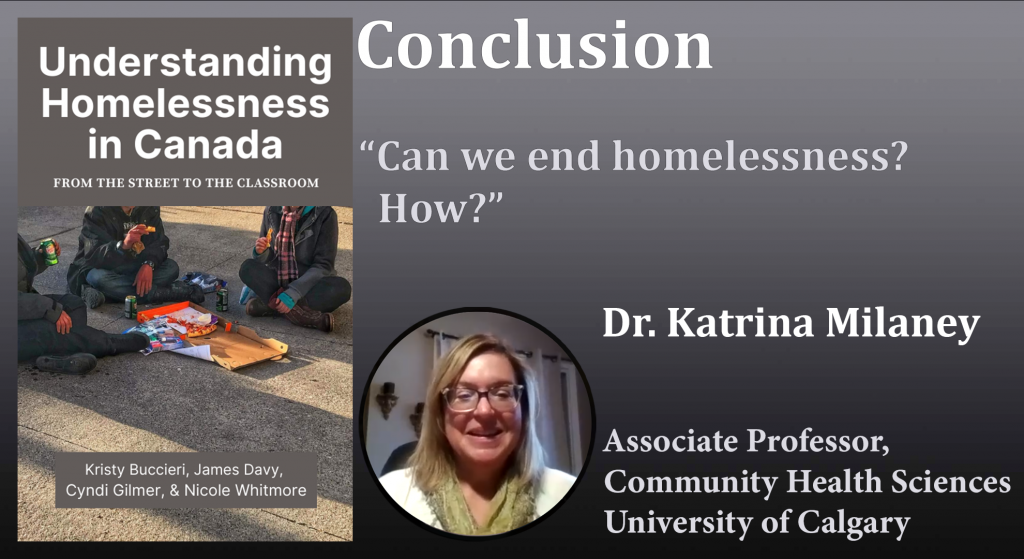 |
 |
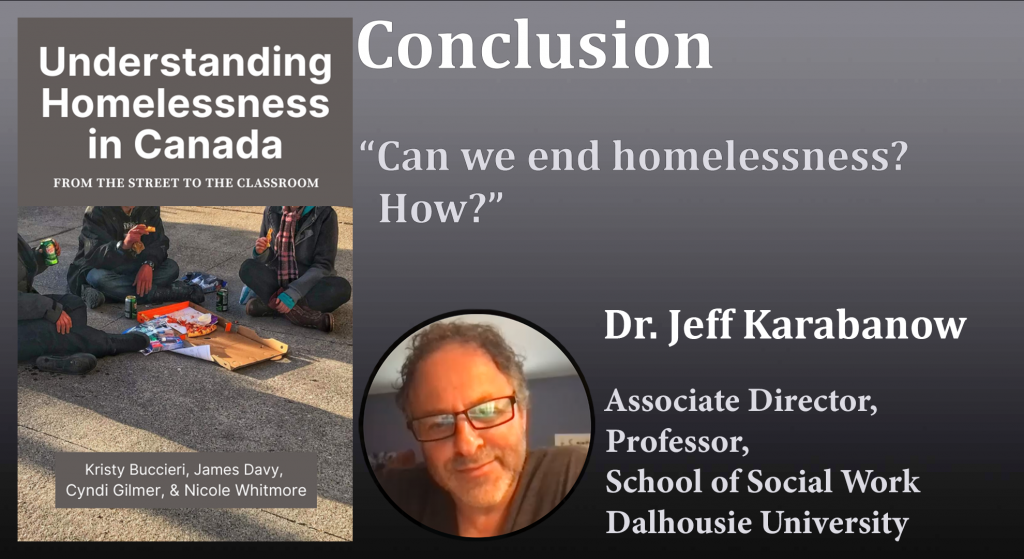 |
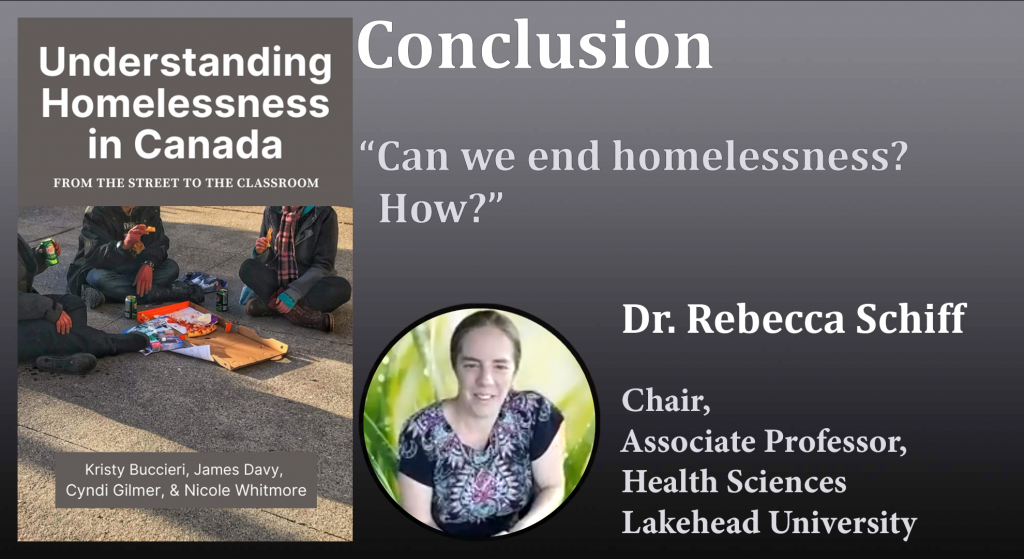 |
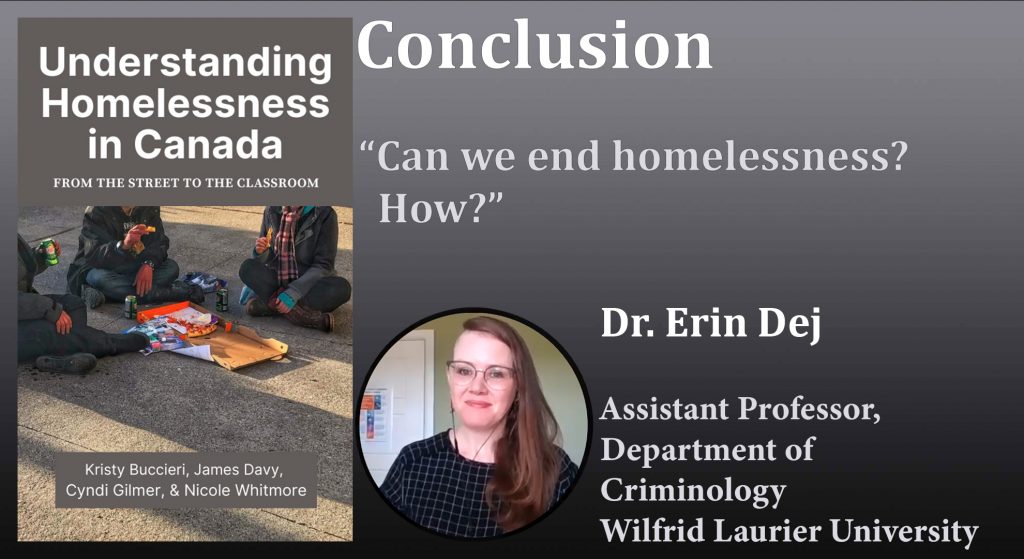 |
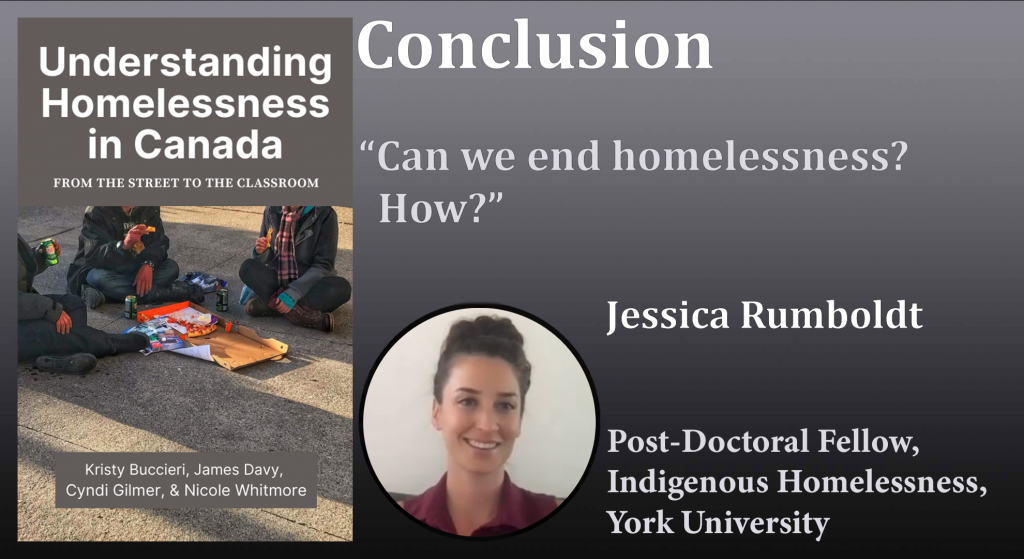 |
 |
Key Takeaways – Milaney, Karabanow, Dej, Abramovich, Thulien, Shiff, and Rumboldt: Can we end homelessness? How?
Dr. Katrina Milaney:
- We can end homelessness because we are already doing it.
- Cities and provinces have done amazing work recently, prioritizing system responses.
- In the last ten years, there has been a shift away from emergency responses towards individualized supports based on people’s specific needs.
- There are still some individuals who are slipping through the cracks because of very complex problems.
- Additional resources and funding are required to address specific needs, such as those that are complex and/or impacted by underlying trauma.
- People need supports related to spiritual healing, with a connection to their language and culture.
- Prevention is key. We are getting better at understanding the need for prevention, particularly for youth and families, which will help stabilize people and stop them from falling into a cycle of homelessness.
Dr. Jeff Karabanow:
- Our current emergency shelter response has not worked for the past 100 years. We can end homelessness if we instead focus on the beginning and end pieces.
- Addressing the beginning of homelessness means deep engagement with preventive measures, such as working with schools and child welfare structures so that people are not left behind or out on the streets.
- Addressing the end of homelessness means being very strategic with purchasing and developing affordable housing units, with collaboration between governments and non-governmental organizations to reduce the number of people living rough.
- We need to have very intentional housing programs that provide the wrap-around supports people need.
Dr. Erin Dej:
- Homelessness is not natural, innate, or inevitable.
- Mass homelessness has not always existed in Canada. It began with housing policy decisions in the 1990s that favoured capitalist culture.
- We created the crisis, and we can undo it.
- We need to lean into the idea of housing as a human right and invest in affordable housing that is safe, permanent, and appropriate for people.
- Housing is a start, but it is not enough. People also need a sense of social inclusion, to be part of a social network, and to feel grounded in their community.
Dr. Alex Abramovich:
- We can end homelessness but there are factors that need to be seriously addressed. One of these is the recognition of how over-represented LGBTQ2S+ individuals are amongst people experiencing homelessness.
- Many existing strategies and policies do not prioritize the needs of LGBTQ2S+ persons, and youth in particular, whose needs are often different than cisgender and heterosexual persons.
- Strategies for ending homelessness will look differently for different populations. There is no one-size-fits-all approach, yet this is not often reflected in how health care, housing, and other programs are implemented.
- We are not going to end homelessness unless we start to prioritize the needs of different populations of people.
- We also have to ensure population-specific programming is available in communities across the country, and not just in major cities per province.
- More education and training are also needed to help people better understand population-specific needs.
- Canada has made some progress, such as through poverty reduction and housing / homelessness strategies.
- There is also an increased willingness to engage in discussion about population-specific homelessness.
- Prevention and early intervention are key. It is difficult to help people successfully exit homelessness, so if we can stop them from experiencing it in the first place, we will be better off in terms of ending it.
- Prevention and early invention programs are particularly important for youth and their families.
Dr. Naomi Thulien:
- How we think about ending homelessness depends on the definition used.
- If we talk about putting people in housing, we can make a large difference in those numbers through some of the great housing programs that are currently being used.
- Housing people is important, but it is only one piece in a complex problem that also requires social and economic solutions.
- We need to help people feel like they belong, are part of a community, and can move forward with a sense of control and choice in their life.
- Preventing homelessness from occurring is more difficult because it means addressing the reasons people become homeless. For youth, this often entails family dysfunction, which is challenging.
- We might be able to reduce homelessness by focusing on prevention, but we may not be able to end it entirely. That does not mean we should not try.
Dr. Rebecca Schiff:
- We can end homelessness with more housing, but it is not as simple as just giving everyone a roof over their head. People need a home that is safe, such as those who are experiencing domestic violence.
- To end homelessness in Canada, there are some big and important things we need to do.
- We need to build more housing.
- We need to adopt Housing First principles, including harm reduction.
- We need to improve institutional transitions, such as in and out of health care and correctional facilities.
- We need to decolonize society by removing all colonial structures and institutions, particularly if we are going to reduce Indigenous homelessness.
- There is no easy way to answer this question. It is about focusing on each individual person’s experience, finding them the right home with the right supports, so that they can become and stay successfully housed in a safe and good home.
Jessica Rumboldt:
- To address Indigenous homelessness, we need a commitment to foster ongoing respectful engagement and equitable relationships with Indigenous communities.
- There have been calls to create a multi-sectoral action plan to open communication, encourage coordination and collaboration between sectors, and develop a community-wide prevention network.
- The Truth and Reciliation Commission of Canada’s [TRC] final report provides a resource to draw on, to help us think about ending Indigenous Homelessness.
- The TRC’s report identified our collective responsibility to apologize for the intergenerational trauma inflicted by residential schools, the need to foster healing and work towards stronger partnerships with Indigenous communities.
- We need to identify resources for conducting ethical research to gather data and determine the number of Indigenous persons experiencing homelessness.
- Researchers in the field have argued there are insufficient statistics to measure visible and hidden homelessness amongst Indigenous peoples.
- The data that is collected must be evaluated to identify core causes of homelessness and to address any service gaps.
- Ending Indigenous homelessness must include housing governance structures that are effective and efficient.
- The new short-term federal investment in affordable housing for Indigenous peoples on and off reserve is only the first step in improving outcomes for Indigenous peoples. Further political, social, and financial investments are needed.
- Housing has to meet the diverse range of individual needs Indigenous persons have, both on and off reserve, without pan-Indigenizing.
- Research suggests there is a willingness in communities to invest time and effort into homelessness prevention efforts, such as through wellness and employment-readiness programs for at-risk individuals.
- We can look to ‘End Homelessness Winnipeg’ as a model of how a community can develop long-term solutions that prevent and end homelessness, with the recommended objectives of improving housing access and supply, a focus on homelessness prevention, assessment and measurement approaches, and person-centred systems of care.
- Efforts to end Indigenous homelessness must be guided by determinations of housing as a human right, such as through the United Nations Declaration on the Rights of Indigenous Peoples and the Truth and Reconciliation report.
[3] Holding the government accountable for social policy, past, present, and future
Over the past several years, there have been positive steps forward in federal policy for housing and homelessness. Notably, we have seen Canada’s National Housing Strategy (Government of Canada, 2017), National Homelessness Strategy (Government of Canada, 2018), and National Housing Strategy Act (Government of Canada, 2019). However, while these are promising initiatives, we cannot forget that the lack of affordable housing and current rates of mass homelessness have resulted from policy decisions made in the 1980s and 1990s. Governments must recognize that the choices they make, through the policies they implement, have a direct impact on homelessness rates in Canada. Governments at all levels [Federal, Provincial / Territorial, and Municipal] need to be held accountable to learn from the past, and from other nations, what measures reduce homelessness, and which do not.
Here we present videos from eight researchers who spoke about the role of the government in needing to have the will to change, learning from past decisions, and looking to other countries for guidance. Here we invite you to watch the responses of Dr. Jeannette Waegemakers Schiff, Dr. Jacqueline Kennelly, Dr. John Ecker, Dr. Nick Kerman, Dr. Nick Falvo, Dr. Stephen Hwang, Dr. David Firang, and Dr. Tim Aubry. Again, we note that you can watch these in any order by clicking on the image and that you should also review the key takeaways in the document that follows. As you watch, be sure to continue thinking about all four priorities that we need to achieve to end homelessness in Canada, as they are all interconnected and will emerge in these videos as well.
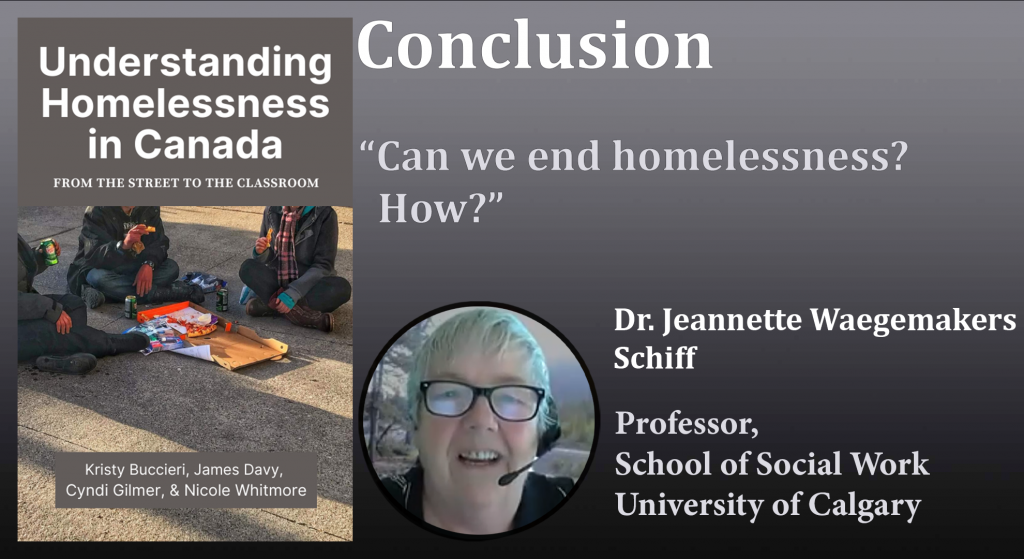 |
 |
 |
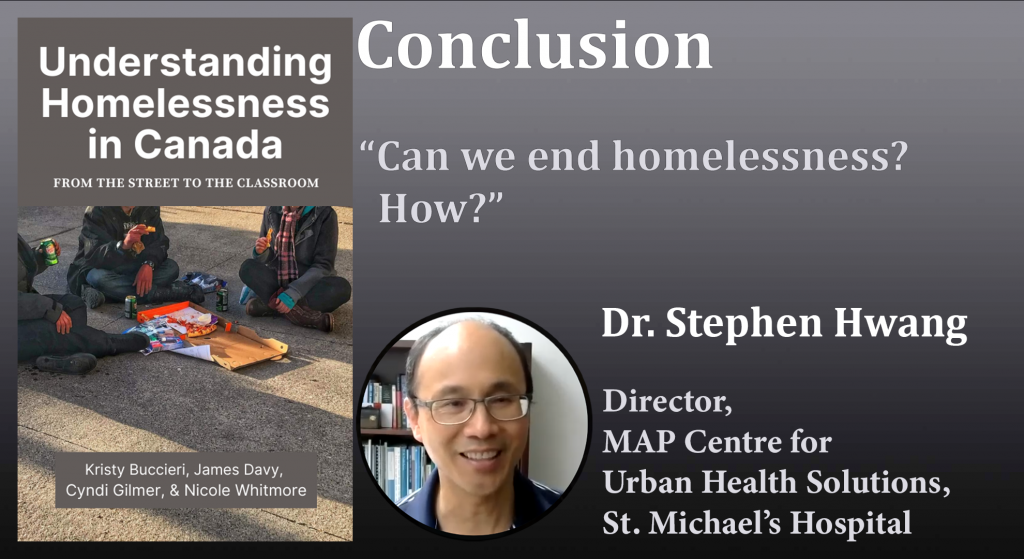 |
 |
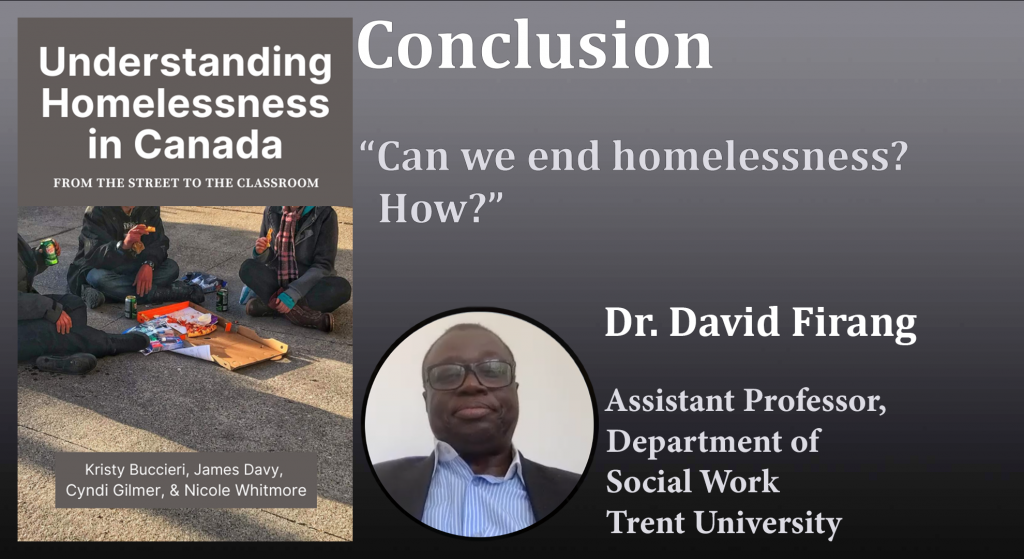 |
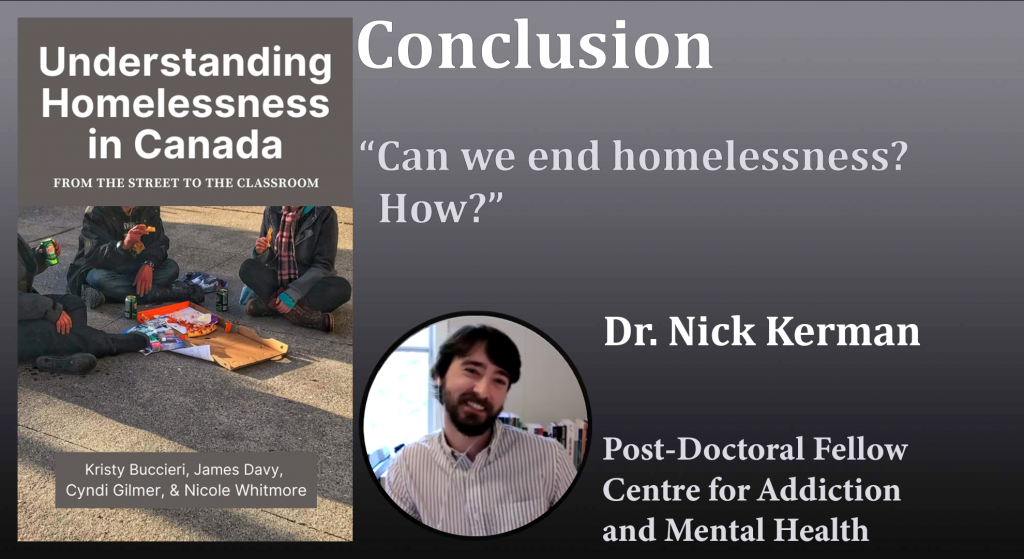 |
 |
Key Takeaways – Waegemakers Schiff, Kennelly, Ecker, Kerman, Falvo, Hwang, Firang, and Aubry: Can we end homelessness? How?
Dr. Jeannette Waegemakers Schiff:
- We could end homelessness if we had the collective political will to recognize it as a shared societal problem that affects all levels of government.
- We need to make enormous investments in creating supportive housing programs. With more housing, we would have fewer social problems.
- Funds can be diverted, over time, away from emergency responses like shelters and directed towards housing subsidies and case management.
- The success of places, like Medicine Hat, in ending homelessness has resulted from strategic investments in housing.
Dr. Jacqueline Kennelly:
- We can end homelessness in Canada, if the government builds more affordable housing, that remains affordable and does not revert to private market rent after a period of time.
- People need deeply affordable housing options that match their actual incomes.
- We need to increase income supports to provide enough social and financial benefits for people to live. This includes increases to financial supports such as welfare rates, disability support programs, shelter allowances, and rent supplements.
- The whole social system is set up to keep people in poverty. We need to hold governments accountable, by voting for parties that are actually committed to building deeply affordable housing and raising income support rates.
- Canada did not have mass homelessness until the Federal government cuts to affordable housing in the 1980s-90s. We have never really recovered from these policy decisions.
- Making change will require that we hold parties to account and educate people about the need for housing and income interventions.
Dr. John Ecker:
- The homelessness rates have remained stable over the past several decades on a national level.
- Some cities, such as Medicine Hat, have essentially ended chronic homelessness. This is a great example of what can be done and should serve as a source of hope for other communities.
- Ending chronic homelessness still does not eliminate all homelessness, so a focus on prevention is necessary.
- We need to think about prevention, such as through better discharge planning from institutions, stronger eviction prevention efforts, and a focus on youth interventions.
- We can look to other countries, like Finland, that have dramatically reduced homelessness by investing in affordable housing and building strong partnerships between all levels of government and the non-profit sector.
- Finland already had stronger social programming than Canada, so the addition of affordable housing resulted in a large and sustained reduction in the number of people experiencing homelessness.
- Canada needs more investments in social housing and community-based mental health and social supports that are tailored to address homelessness amongst Indigenous peoples, racialized and newcomer Canadians, women, youth, and the LGBTQ2S+ community.
- There is no ‘one-size-fits-all’ approach that will work. We need targeted solutions.
- We have all the tools, and we know what to do, but we need partnership-building, the political will, and attached funding to put them in place.
Dr. Nick Kerman:
- We can end homelessness in Canada, if we address three fundamental aspects: developing more affordable housing, providing intensive supports for those who need them, and strengthening our income support programs.
- The first thing we need to do is develop more affordable housing units. Some people simply need affordable housing to get out of homelessness.
- Some people will require specialized intensive supports in addition to affordable housing, such as Assertive Community Treatment attached to Housing First.
- Others may need less-intensive supports, such as case management, but it is important to stay true to the fidelity of the Housing First model for those who need higher levels.
- It starts with getting people into housing, and then providing the ongoing supports that they need.
- Unemployment and disability income supports are often not sufficient to meet the financial needs of people who rely on them.
- These income programs are not working to end homelessness, so transformation is needed. This could include looking into the effectiveness of increasing the rates and/or investing in a universal basic income like the one briefly piloted in Ontario.
- We also have to recognize that many people want to get back into the labour market and set up systems in a way that supports them to do so.
Dr. Nick Falvo:
- The most important aspect of ending homelessness is the need for substantial increases in social investments.
- In the 1990s Canada stopped investing in social housing and programming.
- We are starting to invest more again, under the Trudeau government. It is important this spending on housing and supports continue, regardless of which party is in power.
- Nordic countries provide a model for Canada to learn from and move towards. They spend substantially more on social housing and social protections for vulnerable people.
- Shifting to the Nordic model is the best way for Canada to move the needle on homelessness across the country, and not just in cities with soft (i.e. not competitive) rental markets, such as in Medicine Hat. It is more difficult to end homelessness in cities with competitive rental markets, such as Vancouver and Toronto.
Dr. Stephen Hwang:
- How to end homelessness is something people have spent endless time debating.
- Homelessness could end if there existed the will to work on, and invest resources in, the systemic and societal issues that are driving it.
- At the systemic level, most notably we need to invest in affordable housing for people.
- In addition to housing, we need programs that help people successfully make the transition.
- If we do not address the upstream factors that are driving the problem, we can never solve the problem itself.
- Affordable housing and programs are both needed. We could never end homelessness simply by having more emergency programs and services for people who are currently experiencing homelessness.
- Comparatively, it is like trying to stop lung cancer from happening by improving programs for people who already have it. This approach does not make sense.
- We need to ask ourselves, are we willing to invest our collective resources in addressing the problem?
- Reductions of homelessness in other countries show us that it can be done if housing is affordable.
Dr. David Firang:
- Canada is a country that claims to have an abundance of resources. As a nation, ending homelessness would require those in power to make a commitment.
- Social policy is primarily the responsibility of the government because it has the authority, power, and mandate, but the private sector and individuals also have a role to play.
- How the government understands the issue of homelessness, such as through its ideology, impacts the policy responses it puts in place.
- For example, a government that views homelessness as personal failure will not implement robust income support measures. Instead, it will shift the responsibility to individuals, families, and religious organizations to provide charity.
- From a social democracy ideology, housing and assistance are human rights.
- Canada is a welfare state, even if it has eroded. Our system of governance hinges on the idea that all levels of government need to take active responsibility to ensure people’s needs are met.
Dr. Tim Aubry:
- We do not need to have homelessness. It can be solved with effort, political will to solve the problem, an increased supply of affordable housing, providing people with the supports they need, and implementing a Housing First policy across the board.
- We can learn from Finland, who had drastic reductions in homelessness because they solved the supply problem by implementing Housing First as a policy and focusing on prevention.
- We have the know-how to solve homelessness, we just need to put in place the right policies and programs to be effective.
[4] Preventing homelessness from occurring through systemic change
In the Introduction to this book, we posed the question, “What is homelessness?” and learned about the Canadian Definition of Homelessness (Gaetz et al., 2012) which includes people who are precariously housed and those at-risk of losing their housing. These terms reflect individuals who might have some degree of housing, but it is not suitable for long-term habitation, or they are at risk of losing it if they experience a sudden change like a job loss or relationship breakdown. Instead of placing all of our focus on helping people once they are unsheltered or emergency sheltered, we need to look further upstream. There is a growing body of research and advocacy work that demonstrates the importance of making the shift towards prevention (Dej, Gaetz, & Schwan, 2020; Gaetz; 2020; Gaetz & Dej, 2017). Preventing homelessness before it begins is arguably the best way to reduce the number of people experiencing homelessness. To achieve this goal, systems-level changes are needed, particularly related to discharge from public institutions and by implementing eviction-prevention measures to keep people from losing their housing.
The videos below are from seven researchers who all spoke about the importance of prevention as a priority for ending homelessness in Canada. Here we invite you to watch the responses of Dr. Stephen Gaetz, Dr. Tyler Frederick, Dr. Bernie Pauly, Dr. Bill O’Grady, Dr. Cheryl Forchuk, Dr. Sean Kidd, and Dr. Kelli Stajduhar. To watch these videos, simply click on the images. We also remind you to check out the key takeaways for each video in the document that follows. As you watch them, we encourage you to continue thinking about these four priorities for ending homelessness in Canada, and how they intersect with one another.
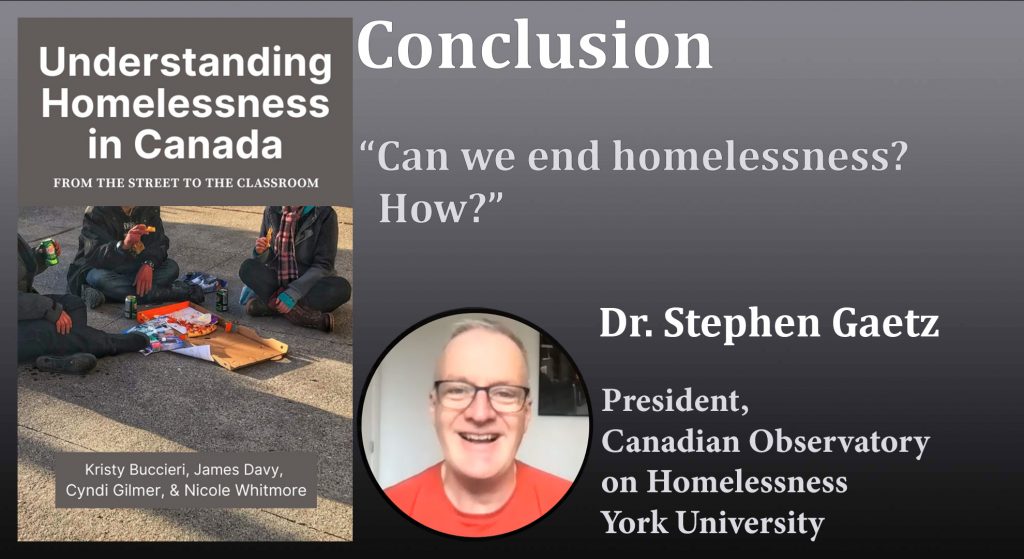 |
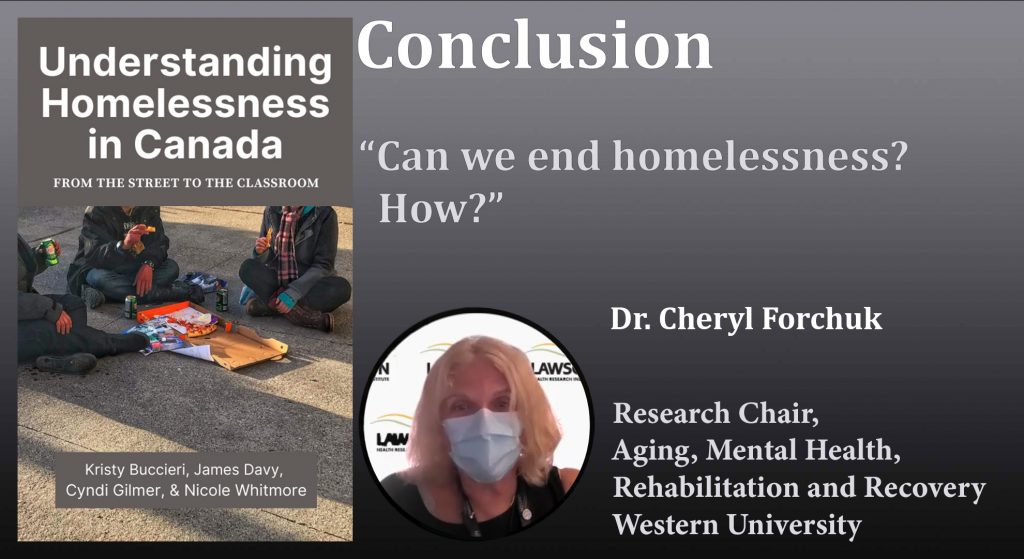 |
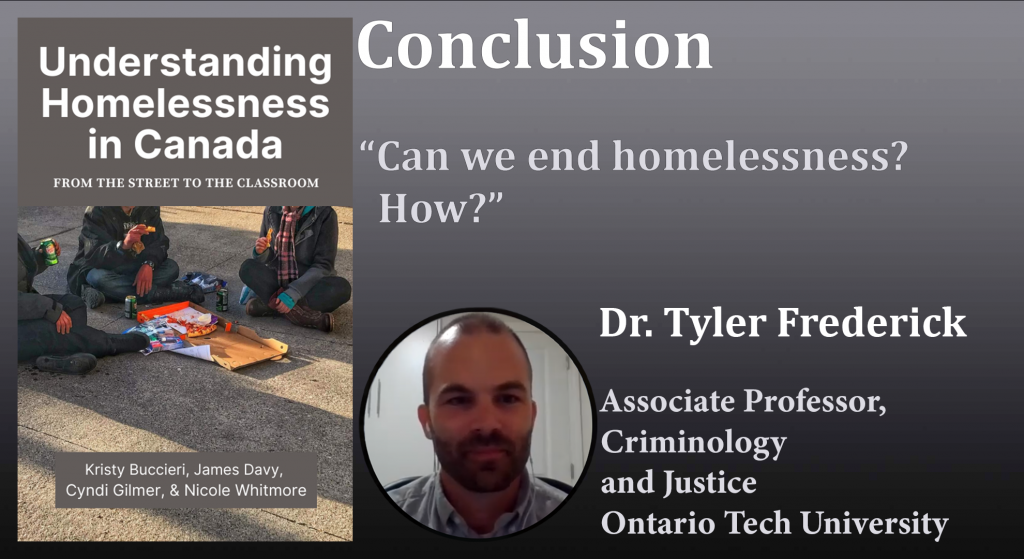 |
 |
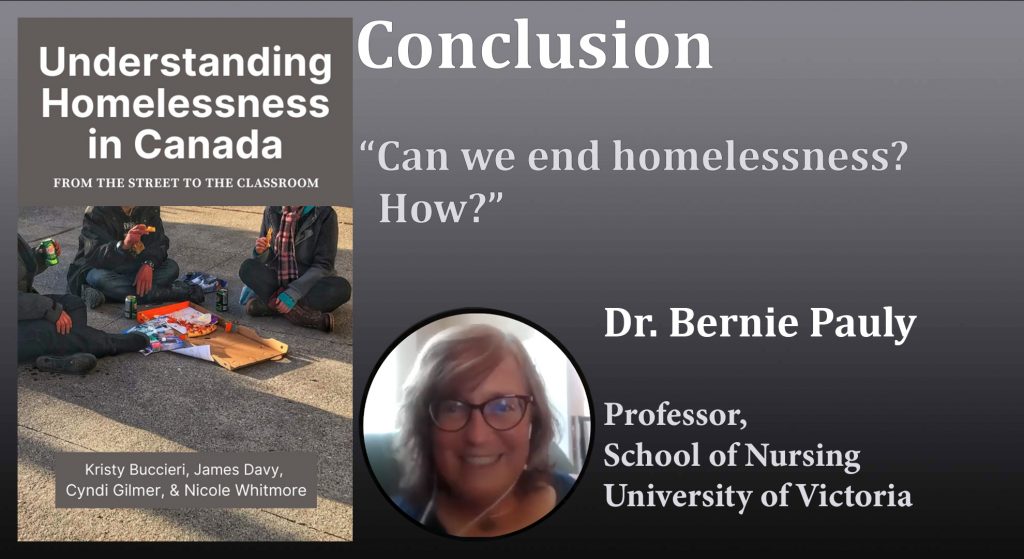 |
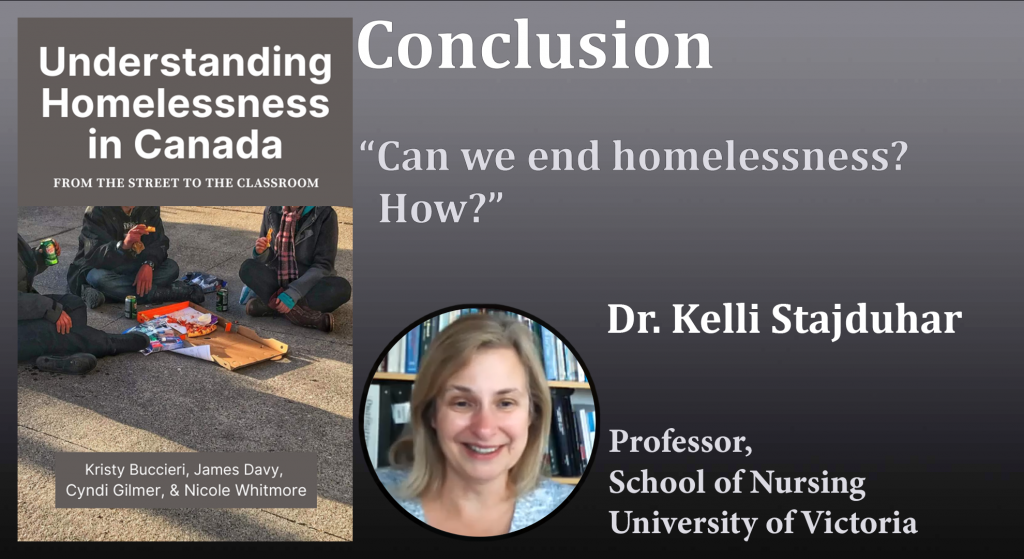 |
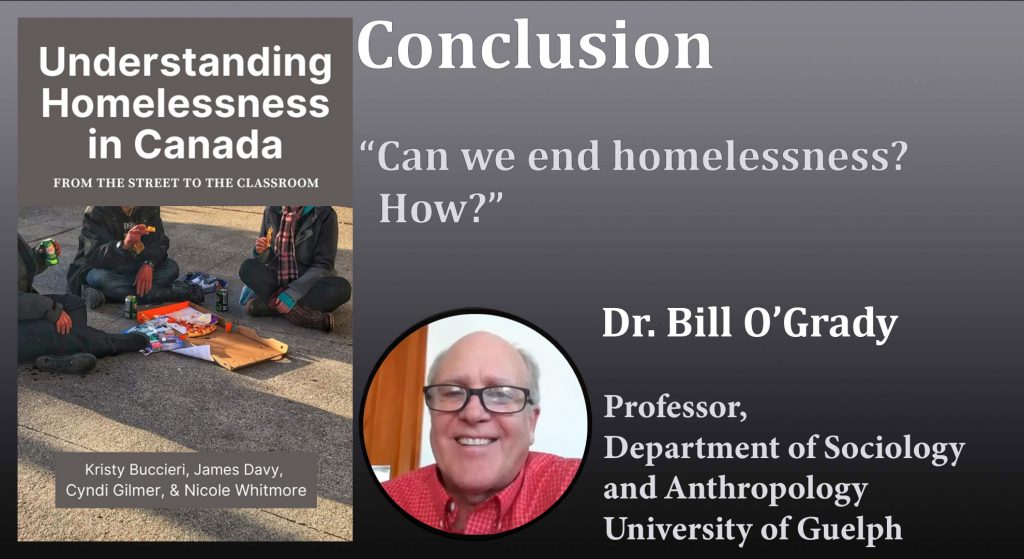 |
Key Takeaways – Gaetz, Frederick, Pauly, O’Grady, Forchuk, Kidd, and Stajduhar: Can we end homelessness? How?
Dr. Stephen Gaetz:
- We can end homelessness, but our current approach will not get us there. There are structural drivers we need to address first, such as the need for more affordable housing and anti-discriminatory practices.
- If we do not focus on prevention, we are going to create more chronic homelessness with people who have to be in crisis before we help them.
- Counties like Finland and Wales have reduced homelessness by focusing on prevention and embedding their homelessness measures in broader poverty reduction and housing strategies.
- Indigenous homelessness needs to be addressed. Approximately 4.5% of Canada’s population is Indigenous, yet they make up 30% of people experiencing homelessness.
- Indigenous peoples will continue to face high rates of homelessness unless Canada, as a country, reconciles our history of colonialism and ongoing racism, addresses sovereignty, and implements the calls to action from the Truth and Reconciliation Commission.
- The homelessness sector cannot end homelessness on its own. We need our public sector institutions, like child protection, the criminal justice system, health care, and education to recognize their practices contribute to homelessness and they are responsible for taking their share of the responsibility to end it.
Dr. Tyler Frederick:
- Ending homelessness begins with prevention.
- We can limit a person’s entry into homelessness, or their loss of housing, through improved discharge planning, such as when a person is leaving a correctional facility, mental health facility, or hospital.
- We need to improve our child welfare system, so that young people are not forced to become independent before they are ready to transition into adult roles. Young people need to have the right supports in place.
- Increasing the stock of affordable housing can end homelessness.
- Increasing affordable housing will require political will and public support.
- Some people simply need access to affordable housing and living wage incomes to move out of homelessness.
- Some people will need additional specialized supports, which may be ongoing or adapted over time if the person no longer requires them.
Dr. Bernie Pauly:
- Homelessness can be ended with the political will to invest in affordable housing.
- In the 1990s we had massive withdrawals from investments in social housing, that we have not replaced. Not only did we not invest in housing, but we also lost existing housing on the low-end of the market.
- The low-end of market units are often bought by investors, but the government could intervene and buy them instead.
- The homelessness-serving system needs to be revised through partnership and engagement with people who have lived experience because it currently resembles the game ‘Snakes and Ladders.’
- For example, housing in Victoria is expensive, costing approximately $1200 a month for a bachelor apartment. A person on social assistance might receive $375 plus $450 a month as a rent supplement. This provides a person with support (to go up the ladder), but not in an amount that is enough for housing (back down the snake).
- If people who had lived experience were engaged in planning the system, it would work in a better way to meet people’s needs.
- To end homelessness, it is critical that we focus on prevention. If we continue to not address the factors that contribute to homelessness – a lack of affordable housing, inadequate income supports, and unsuitable employment – people are going to continue to enter into homelessness.
- Measures such as strong eviction prevention and rapid rehousing policies need to permanently be put in place.
- The COVID-19 pandemic demonstrated that rapidly housing people and implementing eviction moratoriums are possible when there is political will.
Dr. Bill O’Grady:
- People are often divided on the question of whether we can end homelessness.
- The number one thing we need to address homelessness is an adequate supply of safe and affordable housing across the country.
- Currently, many cities have high rents and long waiting lists to get housing supports.
- Housing and social supports should be tailored to the needs of different populations, such as women fleeing intimate partner violence, women with children, families, Indigenous peoples, seniors, youth, and LGBTQ2S+ people. There is no cookie-cutter approach that works for everyone.
- Better systems coordination would improve people’s access to existing services and support programs.
- Improved alignment of services around discharge planning is important in ending homelessness.
- Recently we have recognized the importance of homelessness prevention. This is an important direction, that we should move towards.
Dr. Cheryl Forchuk:
- Homelessness at this level was not always a problem in Canada.
- Discharging patients from mental health facilities into homelessness used to be so uncommon it was considered a form of patient assault.
- The problem of mass homelessness emerged because of bad housing and mental health policies. The good news is it can be fixed, but it is going to take political will and effort.
Dr. Sean Kidd:
- The better question is: in a country like Canada why have we not already ended homelessness?
- It may not be possible to prevent every form of homelessness from occurring, but there is a lot we can do to address on-going or long-term experiences of homelessness.
- Most of what needs to be done is about policy rather than service provision.
- People need job security and a basic minimum income to access affordable housing and live with respect and dignity.
- Prevention efforts are needed, such as to help families address stress that can lead to youth homelessness.
- To address Indigenous homelessness, we need to ensure we are attending to Truth and Reconciliation commitments regarding intergenerational trauma and the array of discriminations Indigenous peoples face.
- We must address the quality of life for people living on reserves, and ensure they have the necessities of life.
- In a system designed to end homelessness, shelters would exist for a very specific purpose of short-term stays for small numbers of people, with supports designed around housing, employment, and mental health. Housing First is a model that is consistent with this approach.
- People experiencing homelessness and severe mental illnesses could be supported in the health care system, with proper transitions into supportive housing rather than discharge into homelessness.
- We need to improve systems alignment. Currently, it is a hodgepodge of agencies that exist through cobbled together grants. What we need is a well funded system that overhauls health care and supportive housing.
- There are countries that have successfully undertaken these kinds of overhauls.
- Roosevelt’s New Deal during the Great Depression was one such systemic overhaul that greatly reduced homelessness in America.
- Although some people may be resistant to invest money in these approaches, a well-run system benefits everyone
Dr. Kelli Stajduhar:
- The only way we end homelessness is by getting people housed.
- Beyond having a roof, it has to be housing that works for the person.
- We need to consider the reasons a person might be experiencing homelessness, such as intergenerational trauma, and the specific supports they need.
- Housing options should be designed with people who have lived experience of homelessness.
- It is important to recognize the resiliency and capacity to self-organize that people who experience homelessness have. We need to listen to them because they will know what works best for them.
- If we take our assumptive blinders off and put our biases aside, we will see some pretty incredible people.
What do you think?
Now that you have heard what everyone had to say, what is your opinion? Has your response to this question changed at all from what you wrote down at the beginning of the chapter? Share your thoughts with us by tweeting @Homeless_ebook and using the hashtag #UnderstandingHomelessness.
Podcast: Part 1 – Can we end homelessness, how? (54:27)
Click the link below to listen to all of the researchers answer the question “Part 1 – Can we end homelessness, how?” in audio format on our podcast!
Podcast: Part 2 – Can we end homelessness, how? (47:09)
Click the link below to listen to all of the researchers answer the question “Part 2 – Can we end homelessness, how?” in audio format on our podcast!



